Fortress Europe has gone live on Forces, so now you can get to putting together a Late War list for your Launch Weekend battles!
Get cracking on your German, Soviet, British, or American Late War lists here…
Join the Battlefront team as we launch Bagration: Soviet
Fortress Europe has gone live on Forces, so now you can get to putting together a Late War list for your Launch Weekend battles!
Get cracking on your German, Soviet, British, or American Late War lists here…
Join Wayne as he unboxes the German Starter Force:
with Wayne Turner
I’ve decided to put together a StuG Assault Gun Company for the Kursk period from Ghost Panzers. By June 1943 many Assault Gun Battalions (Sturmgeschütz Abteilungen) had started to be equipped with the latest version of the StuG assault gun, the StuG III G armed with the long 7.5cm StuK40 gun. The 301. Panzer Battalion chosen as the theme unit in Ghost Panzers is a radio control unit that also contains Borgward demolition carriers, but by not taking the Borgward options it can also be used to represent any of the Assault Gun Companies or Batteries that served on the eastern front.
At Kursk in particular there are a number of Assault Gun Battalion or Brigades involved in the operations. Sturmgeschütz Abteilungen 904 (31 x StuG III) and 245 (22 x StuG III and 9 x StuH 42) served with XXXXVII Panzer Korps on the north side of the salient. Sturmgeschütz Abteilungen 177 (22 x StuG III and 9 x StuH 42) and 244 (22 x StuG III and 9 x StuH 42) served under command of XXXXI. Panzerkorps.
In addition a number of divisions had their own assault gun units. 78. Sturm Division had Sturmgeschütz Abteilung 189, Panzergrenadierdivision ‘Grossdeutchland’ had Sturmgeschütz Abteilung ‘Grossdeutchland’, 7. Infanteriedivision’s Panzerjäger Abteilung 7 contained one company equipped with StuG III, and 6. Infanteriedivision’s Panzerjäger Abteilung 6 contained one company equipped with StuG III.
To be a bit different I’m going to base my StuG force on 6. Infanteriedivision, representing the Sturmgeschütz Kompanie (Assault Gun Company) of Panzerjäger Abteilung 6 (6th Tank-hunter Detachment/Battalion). 6. Infanteriedivision fought in the middle of the 9thArmy’s attack on the north of the Kursk Salient and pushed as far as Olkhovatka during the battle along with the Panzertruppen. During the fighting the divisions also has the 1st and 2nd Companies of Heavy Panzer Battalion 505 (Tiger IE heavy tanks) and Panzerkompanie (Fkl) 312 attached.
My Force
13 pts StuG (Late) Assault Gun Company HQ, 1x StuG (late 7.5cm)
39 pts StuG (Late) Assault Gun Platoon, 3x StuG (late 7.5cm)
39 pts StuG (Late) Assault Gun Platoon, 3x StuG (late 7.5cm)
That’s 91 points. I’ll make this up to 100 points, but I haven’t decided what to spend my last 9 points on as yet.
with Mike Haught
The centerpiece battle in Iron Cross is Stalingrad. This battle is accurately characterized as an infantryman’s fight, with over 15 German and 25 Soviet infantry divisions present. The difficult terrain of city fighting kept tanks and assault guns in a supporting role, leaving the heavy lifting to the foot soldiers. Within all of these infantry divisions there was also a lot of variety, with specialist troops on both sides brought in to deal with the challenges of urban fighting.
The infantry formation options in Iron Cross and its command card deck give you lots of options to explore the variety of infantry forces fighting in Stalingrad and across the whole Eastern Front. Let’s have a look at the grenadiers in Iron Cross.
Infantry Formations from Iron Cross
Iron Cross features three infantry formations: motorised infantry that would become panzergrenadiers, the regular infantry known later as grenadiers, and the lethal troops of the assault pioneer battalions. These three forces set the standard for the bulk of German infantry forces in Stalingrad, but there were more… lots more!
Infantry Formations from Command Cards
To cover as many infantry variants as possible, we’ve added several new command cards that converts your standard Grenadier company into a special unit. You can easily change the flavour of your units just by using one of these cards and adding or removing a few small things here and there. Each variant has its own set of advantages and challenges to explore, giving you many hours of entertainment.
Croatian Rifle Company
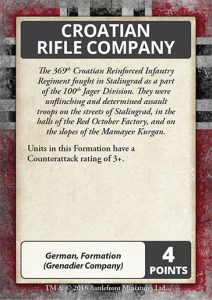
The German pioneers spoke highly of the Croatians, noting their steadfast determination to finish their assaults. This gives the Units of your Grenadier formation a better Counterattack rating, going from the usual 4+ to a 3+ to continue fighting assault combat.
Fast Company

The Fast Company command card lets you create one of these vanguard units. You will have some infantry and armoured cars to race ahead and secure the objective as well as a high concentration of anti-tank guns, including the formidable 7.5cm PaK40. If you pair this card with the Softskin Transport upgrade card for your foot-mounted troops, you will have tremendous mobility to grab the best ground on the battlefield well ahead of slower enemy infantry.
Gebirgsjager Company
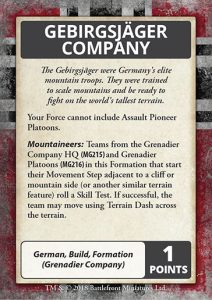
Gebirgsjäger give up their heavy equipment in order to free up their supply lines and make it easier to get into battle. To that end, they replaced the typical 10.5cm artillery their own 7.5cm guns that they could break down and carry by mule through the difficult mountain terrain. You can field these guns using the Mountain Artillery command card to replace your 10.5 leFH18 guns with a battery of smaller 7.5cm guns.
Jager Company
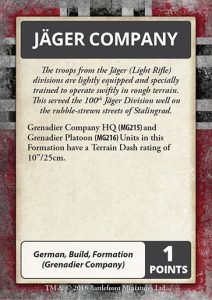
The Jäger Company command card gives your Grenadier HQ and Grenadier Platoon Units a Terrain Dash bonus of +2”/5cm, allowing you to get your combat troops to where they are needed more quickly, especially through a ruined cityscape.
Luftwaffe Field Company
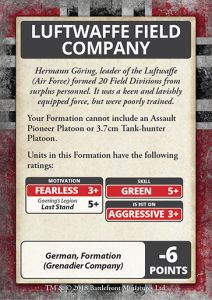
You can field one of Göring’s companies using the Luftwaffe Field Company card. You’ll see a sharp increase in the motivation of your troops but at the cost of training.
Pioneer Company

This command card focus more on the operational pioneer units where their job was more about clearing mines and digging in to hold a critical objective.
SS-Grenadier Company
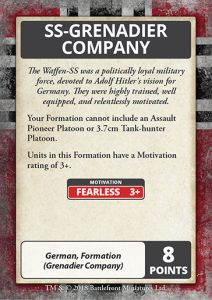
Both the SS and Großdeutschland were well supplied, highly motivated, and considered elite, so the SS-Grenadier Company command card can be used to give both units a solid 3+ Fearless Motivation rating.

If you want to find out more about the cards included in the Iron Cross Command Card Pack you can click here…
~Mike